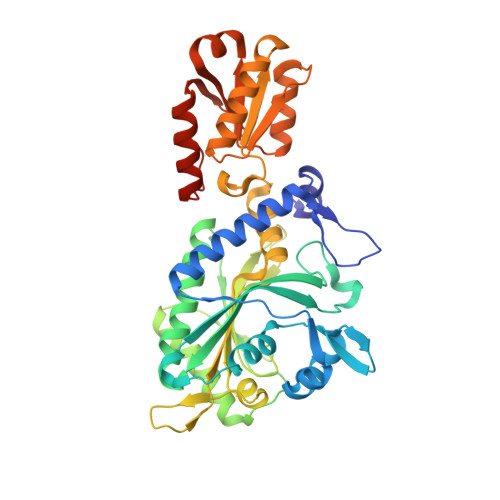Tyrosine-targeted covalent inhibition of a tRNA synthetase aided by zinc ion.
Qiao, H., Xia, M., Cheng, Y., Zhou, J., Zheng, L., Li, W., Wang, J., Fang, P.(2023) Commun Biol 6: 107-107
- PubMed: 36707692
- DOI: https://doi.org/10.1038/s42003-023-04517-7
- Primary Citation of Related Structures:
8H98, 8H99, 8H9A, 8H9B, 8H9C - PubMed Abstract:
Aminoacyl-tRNA synthetases (AARSs), a family of essential protein synthesis enzymes, are attractive targets for drug development. Although several different types of AARS inhibitors have been identified, AARS covalent inhibitors have not been reported. Here we present five unusual crystal structures showing that threonyl-tRNA synthetase (ThrRS) is covalently inhibited by a natural product, obafluorin (OB). The residue forming a covalent bond with OB is a tyrosine in ThrRS active center, which is not commonly modified by covalent inhibitors. The two hydroxyl groups on the o-diphenol moiety of OB form two coordination bonds with the conserved zinc ion in the active center of ThrRS. Therefore, the β-lactone structure of OB can undergo ester exchange reaction with the phenolic group of the adjacent tyrosine to form a covalent bond between the compound and the enzyme, and allow its nitrobenzene structure to occupy the binding site of tRNA. In addition, when this tyrosine was replaced by a lysine or even a weakly nucleophilic arginine, similar bonds could also be formed. Our report of the mechanism of a class of AARS covalent inhibitor targeting multiple amino acid residues could facilitate approaches to drug discovery for cancer and infectious diseases.
Organizational Affiliation:
State Key Laboratory of Bioorganic and Natural Products Chemistry, Center for Excellence in Molecular Synthesis, Shanghai Institute of Organic Chemistry, University of Chinese Academy of Sciences, Chinese Academy of Sciences, Shanghai, 200032, China.


















